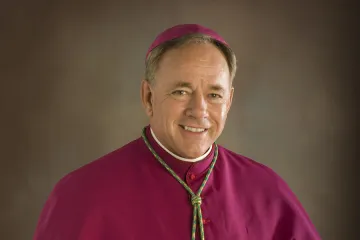Kamloops, Canada, Jun 7, 2021 / 14:00 pm
The chief of the Tk̓emlúps te Secwépemc, or Kamloops Indian Band, has condemned the vandalism of St. Joseph’s Catholic Church in Kamloops shortly after the discovery of indigenous children’s graves at a nearby Church-run residential school.
“We are deeply disturbed to learn that the Saint Joseph’s church was vandalized. The church was built from the ground up by Tk̓emlúps te Secwépemc members. We understand the many emotions connected to a Roman Catholic run residential school. At the same time, we respect the choices that Tk̓emlúps te Secwépemc ancestors made, over a 100 years ago, to erect this church,” read a May 31 statement from Rosanne Casimir, the band’s chief.
On the weekend of May 22, the remains of 215 indigenous children were found in unmarked graves at the Kamloops Indian Residential School. The discovery was made with ground-penetrating radar. It is unclear how the children died.
Graffiti reading ‘banished’, ‘evicted’, and ‘crime scene’ was found spray painted on the walls of St. Joseph’s May 31. An ‘X’ was on the front doors.
By the next day the graffiti had largely been cleaned off, Kamloops This Week reported.
The residential school in Kamloops operated from 1890 until 1978. The school was administered by the Oblates of Mary Immaculate from 1893 until 1969, when the Canadian government took control of the school again. At that point, the school building operated as a residence for First Nations children who were attending area day schools. The residence was closed in 1978.
The Kamloops school was at one point the largest school in the entire residential school system, which was established in Canada beginning in the 1870s and was overseen by the Catholic Church and Protestant ecclesial communities. The last operating residential school closed in 1996.
A Truth and Reconciliation Commission which operated from 2008 until 2015 reported on a history of abuses in the system. Children from First Nations and other indigenous communities were separated from their families and placed in the residential schools as a means of forcible assimilation and enculturation. An estimated 4,100 to 6,000 First Nations and other indigenous children died as a result of neglect or abuse in the system, the commission found.
One of the calls of the commission was for a papal apology “to Survivors, their families, and communities for the Roman Catholic Church’s role in the spiritual, cultural, emotional, physical, and sexual abuse of First Nations, Inuit, and Métis children in Catholic-run residential schools.”
In a 2017 meeting with the pope, Canadian Prime Minister Justin Trudeau invited Pope Francis to visit Canada and apologize for the treatment ofiIndigenous children in the schools.
Pope Francis on June 6 expressed sorrow over the discovery of the unmarked graves at the site of the Kamloops school, and prayed for all children who died in the residential school system.
Archbishop J. Michael Miller of Vancouver has expressed a “deep apology and profound condolences to the families and communities that have been devastated” by the discovery at the site of the former Kamloops Indian Residential School.
Archbishop Miller repeated his 2013 apology to the indigenous populations for the abuses that occurred in Church-run residential schools, saying that he remains “committed and accountable” to those words.
“I wish to apologize sincerely and profoundly to the survivors and their families, as well as to those subsequently affected, for the anguish caused by the deplorable conduct of those Catholics who perpetrated mistreatment of any kind in these residential schools,” said Archbishop Miller.
Archbishop Miller said that “the Church was unquestionably wrong in implementing a government colonialist policy which resulted in devastation for children, families and communities,” and that his apologies “must be accompanied by tangible actions that foster the full disclosure of the truth.”
Archbishop Miller pledged to be “fully transparent with our archives and records regarding all residential schools.”
(Story continues below)
He said that records related to the Kamloops Indian Residential School, located in the territory of the archdiocese until 1945 when the Diocese of Kamloops was created, were given to the Truth and Reconciliation Commission.
“We commit to supporting the same process and resources to all Nations in whose territories Catholic-run residential schools were forcibly located, and which fall within the historical boundaries of the Archdiocese of Vancouver,” he said.
Bishop Joseph Nguyen of Kamloops issued a statement May 28 saying he was “heartbroken and horrified” by the discovery of the children’s remains.
“I express my deepest sympathy … to all who are mourning this tragedy and unspeakable loss,” said Bishop Nguyen. “No words of sorrow could adequately describe this horrific discovery.”
Bishop Nguyen said that he offered his “personal support, prayers and accompaniment to our First Nations community in Kamloops and beyond.”




.jpg?w=360&h=240)

